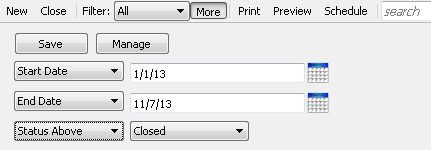
|
xTuple ERP Reference Guide |
On several screens throughout xTuple ERP you are able to create—and save—custom search filters for getting at the data you really need. This search capability can be found, for example, on the Incident Workbench in the CRM Module. The following graphic shows the basic features of the search filter:

You build custom searches using the "+" and "-" buttons featured on the search widget, as shown above. Use the "+" button to add new search parameters. (There's no limit to the number of parameters you can add.) And use the "-" button to remove those parameters you don't want.
Search filters can be saved—and also shared with other users. And when you're done building a query, simply save it. When saving you will have the option to share the filter, or not, depending on your preference.
Some parameter lists allow you to select multiple options from the same list. Look for drop-down lists that remain expanded after you select them. This indicates you may choose more than one parameter from the list of available options.
The MANAGE button brings you to the list of saved filters—both your private ones and any others that are shared across your organization. When managing your filters you can choose to either share them or remove them from the list. If a filter appears in the "Apply Filter" drop-down list, that means it's a saved filter. Only saved filters will appear in that list.
Think twice before deleting a shared filter. Other people may be using it.
The search filter handles date values in two different ways. Dates may be either absolute or relative.
An absolute date is always the date that you entered. For example, it you enter a date using the calendar tool—or manually type in 04/05/2010—the filter will honor that date always.
Relative dates shift over time. So, for example, you may want to always search for information that is new today. Rather than manually entering today's date, then, you would enter "0" in the search parameter date field. Today's date will appear there today. But tomorrow, the date will be tomorrow's date. And so on, with the current date always being used by that parameter. To learn more about the full range of date shortcuts available for entering relative dates, please see Section 2.2.5, “ Date Shortcuts”.
Once you've created a working catalog of search filters, you may decide you don't want to always see the details. The MORE button allows you to show or hide parameter details, as you wish. Click the MORE button once to reveal the underlying parameter details. Click it again to hide them.
The "Default" filter will vary on a screen-by-screen basis.